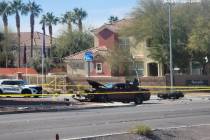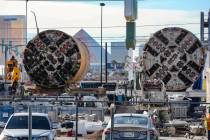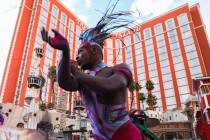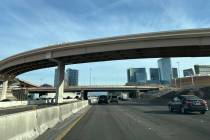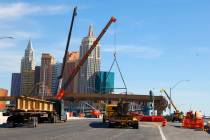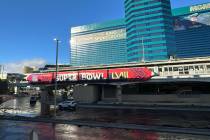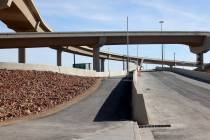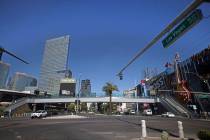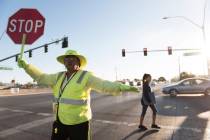Buckle up: It’s simply a matter of life or death
My family and friends didn't remember my anniversary on Monday.
I don't blame them. It's not a happy one.
Seven years ago on Nov. 5, I fell asleep while driving and crashed my car head-on into one of the giant oak trees that in places line the sloping roads of eastern Connecticut.
The tree was fine. My car and body were not.
I was 23 and alive because I wore my seat belt.
It was a brisk New England Sunday morning, about 7 a.m. I was running late for an assignment. I was probably driving over the speed limit, but couldn't say by how much.
I have little memory of the crash itself, but remember when a Lebanon, Conn., firefighter woke me up. What a sight I must have been, slumped over the steering wheel with blood staining my chin because I had bitten my tongue nearly in half.
Before that moment I feigned toughness because I was a kid from Brooklyn, U.S.A.
Those delusions disappeared that morning, when I asked the firefighter to hold my hand because I was scared.
He kindly obliged. He stayed with me as his comrades broke the already shattered front windshield and then cut the roof off my car.
The cool air brushed over me and I looked up at the monstrous tree in front of me and the twisted and crunched metal that used to be the engine of my 1983 Saab 900.
I cursed from the pain in my head and chest and thanked the firefighters.
I announced that I was not paralyzed because I could wiggle my toes. I figured my right leg was stuck because I couldn't move it. The firefighters told me it was probably broken.
I was put in a neck brace as the firefighters prepared to take me from the car. I told them I weighed 300 pounds and asked them not to drop me. They told me not to worry.
When they took me out of the car and placed me on a backboard, I yelped and cursed in pain.
I cried during the ambulance ride to Windham Hospital.
In the emergency room I wanted to go to sleep, but the nurses said I had to have X-rays and gave me insurance forms to fill out.
A nurse inserted a catheter. I won't get into the details, but it wasn't pleasant.
I'll never forget the solitude and claustrophobia of the MRI. I was inserted into a tube while a scan was done of my brain looking for bleeding or damage. It felt like I was in a coffin, which didn't help my mental state after the near death experience.
When my sister Mary Ann made it to the hospital, her face was red, and tears were streaming down her cheeks. She looked frightened and worried but happy that I was talking.
Next I was able to call my parents in Brooklyn.
My first words were "Listen, I'm OK. My leg is broken. I've been in a car accident." But because of my split tongue I didn't sound like myself. My mother became hysterical. She told me later that she thought I had suffered brain damage.
I soon learned from a doctor that I had a "commuted fracture of my right femur." Basically, the largest bone in my body had shattered in half like a broken glass bottle.
Surgery was necessary. A metal rod would be inserted in the bone. The healing process probably would take about a year.
The surgery was scheduled for the next day after which I was put into a medically induced coma.
I slept through the presidential election of 2000: George W. Bush vs. Al Gore.
When I woke from the coma, I didn't know who the president was. Neither did the rest of the nation, I learned.
I spent the next few days waking only to click the morphine-dispensing button and fall back asleep. Amid that intoxication, I was asked by hospital staff to make important decisions such as where I would spend my rehab stint. My responses were groggy at best.
I eventually moved to a rehab facility where I learned my muscles had atrophied. I began a workout regimen, but pushed too fast and strained my back muscles.
While trying to walk on parallel bars, I felt a shooting pain in my right leg. My femur began to split where it curves causing the doctor to order another surgery.
My first surgery had required three short incisions between my right thigh and my knee. My second included a nine-inch cut.
I woke up in the post operating room and cried out. I wept uncontrollably and begged for morphine.
I have never felt more physical pain than I did that day.
My leg was now stronger than a steel rod, but I wouldn't be able to walk again until the bone had completely healed. It would take seven to 10 months.
For the next seven months I either rolled around in my wheelchair or hopped with a walker.
I attempted to satisfy my intellectual curiosity by reading but more often found myself playing video games.
I watched the Food Network religiously and practiced with whatever food my sister brought home from the grocery store. I must have made 30 loaves of banana bread until I got it right.
I didn't work. I didn't date. I didn't go out on Friday or Saturday nights.
When I was finally cleared to walk with a cane, I had to have a lift built into my shoes because my right leg was almost an inch shorter.
My world opened up. I stopped playing video games and rejoined the work force.
If you met me today, you wouldn't necessarily know what I've been through. I walk normally.
But I still remember Nov. 5, 2000, every time I climb stairs and my knee feels like giving out, or when I wake up in the middle of the night tossing and turning because my hip feels like it's on fire, or when inclement weather comes to town and my leg hurts seemingly for no reason.
As a newspaperman, I've grieved with families who have lost their children because they didn't wear their seat belts. They've asked me to tell other parents to teach their teenagers that they aren't indestructible, that seat belts do save lives.
Those families will never forget the dates of their children's crashes.
I suppose that makes me glad my family and friends don't remember mine.
If you have a question, tip or tirade, call the Road Warrior at 387-2904, or e-mail him at roadwarrior@reviewjournal.com or fmccabe@reviewjournal.com. Please include your phone number.
ROAD WARRIORMORE COLUMNSDiscuss this column in the eForums!
A freeway ramp meter will begin operating at the Interstate 15 northbound onramp from Sahara Avenue on Tuesday, the Regional Transportation Commission announced.
The left two traffic lanes of Tropicana Avenue will be closed between Island Way and Duke Ellington Way, just off the Strip, from 9 p.m. Saturday to 5 a.m. next Sunday, for repairs to the pedestrian railing, the Nevada Department of Transportation announced. Motorists should watch for lane shifts.
Las Vegas Boulevard, between Spring Mountain Road and Convention Center Drive, will be closed around 2 a.m. Tuesday for the implosion of the New Frontier, the Clark County public works department announced.
Desert Inn Road will be shut down just before the implosion and should reopen immediately if no debris falls on the road. Las Vegas Boulevard could be reopened 30 minutes after the implosion if no debris falls on the road.
The following road work can be expected because of the Clark County Water Reclamation District sewer pipeline rehabilitation project: Two northbound lanes of Nellis Boulevard will be closed from Cheyenne Avenue to just north of Gowan Road from 9 p.m. to 5 a.m. from Tuesday through Thursday.








